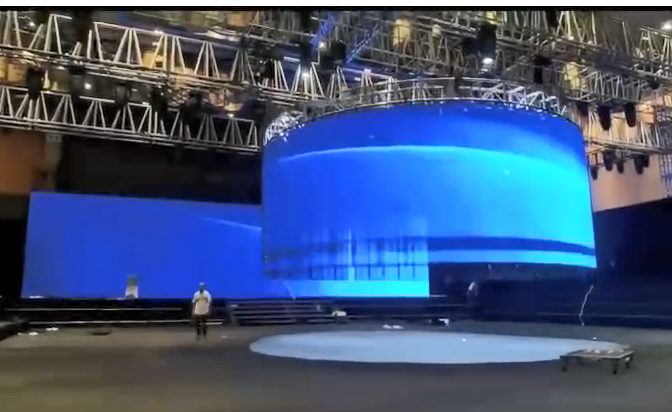Ошибка формата электронной почты
emailCannotEmpty
emailDoesExist
pwdLetterLimtTip
inconsistentPwd
pwdLetterLimtTip
inconsistentPwd

Новости
Здесь вы можете описать кусок текста, который хотите выразить

Holographic Screens: The Future of Display Technology and Its Potential Applications
In recent years, holographic displays have captivated both the scientific community and the general public, opening up new realms of possibility for how we experience visual content. As the technology behind holographic screens evolves, it promises to redefine our interactions with digital media, transforming industries from entertainment to healthcare. This blog post will explore the future of holographic screen technology, its potential applications, and how it could shape the world we live in.
What are Holographic Screens?
Holographic screens use light to create three-dimensional images without the need for special glasses or headgear. Unlike traditional 2D displays, holographic displays use advanced techniques such as interference patterns, lasers, and diffraction to project light in a way that simulates depth, offering a much more immersive and realistic visual experience. This technology is still in its early stages but is rapidly progressing, fueled by advancements in optical science, computing power, and material design.
The Future of Holographic Displays
The promise of holographic displays lies in their potential to deliver experiences that go far beyond current 2D and even 3D screens. Unlike traditional methods, which often rely on flat or stereoscopic images, holography offers the ability to generate true 3D images that appear to float in space. In the future, we could see these displays become commonplace, with applications in entertainment, advertising, education, medicine, and even our daily lives.
One of the key factors driving this evolution is the improvement in the resolution and realism of the holographic images. As the pixel density improves and more sophisticated rendering techniques are developed, holograms will be able to display intricate details with lifelike clarity, making them indistinguishable from real-world objects. Additionally, the development of more compact and efficient hardware will allow holographic displays to become more affordable and accessible to a wider audience.
Potential Applications of Holographic Screens
1. Entertainment and Media
Perhaps the most exciting application of holographic displays is in the entertainment industry. Holographic technology could allow for the creation of fully immersive movies, concerts, and video games where users can interact with virtual characters and environments as if they were physically present. Imagine watching a movie where the characters come to life and move around you, or playing a game where you can physically walk through a 3D world, interacting with objects and characters in real-time.
Music performances, in particular, could be revolutionized. Artists could perform holographic concerts, where audiences from all over the world can attend and interact with the holographic projection of the performer. This technology could bring back deceased legends like Michael Jackson or Tupac Shakur for virtual performances, creating new forms of entertainment and nostalgia.
2. Healthcare and Medical Imaging
Holographic screens hold significant potential in the field of healthcare. In medical imaging, doctors could use holographic displays to visualize organs, tissues, and blood vessels in 3D, offering a more detailed and accurate view than traditional 2D images. This would allow for better diagnoses and more precise surgeries, as medical professionals can better understand the intricacies of a patient's body before performing any procedures.
Furthermore, medical training could benefit from holographic technology. Medical students could use holographic projections to study anatomy in greater detail, virtually dissecting bodies without the need for cadavers. Surgeons could also practice complex procedures using holographic simulations, gaining hands-on experience in a risk-free environment.
3. Education and Training
The potential for holographic screens in education is also vast. Holograms could be used to create interactive learning experiences where students engage with 3D models of historical artifacts, biological systems, or complex machinery. Instead of relying on textbooks and flat images, students could explore subjects from a new perspective, making learning more engaging and memorable.
For training purposes, professionals in fields like aviation, engineering, and even military operations could use holographic simulations to hone their skills in a controlled, immersive environment. This approach would allow for realistic, hands-on training without the risks or costs associated with physical simulations.
4. Advertising and Retail
In the world of advertising and retail, holographic displays could offer entirely new ways of presenting products and services. Imagine walking through a shopping mall and seeing holographic displays that showcase products in 3D. Consumers could interact with the displays, getting a closer look at the features, specifications, and even try out the products virtually.
For advertisers, holograms could be used to create captivating ads that engage customers more effectively than traditional static or video ads. Holographic billboards, product demonstrations, and interactive storefronts could draw customers in and create a memorable experience.
5. Communication and Remote Interaction
Holographic technology could also transform how we communicate. Instead of relying on video calls with 2D screens, we could project lifelike 3D holograms of ourselves during virtual meetings, making long-distance communication feel more personal and natural. This could significantly impact industries like business, remote work, and social interaction, fostering stronger connections across distances.
For family members and friends who are far away, holographic screens could offer a more intimate form of interaction, allowing loved ones to feel like they are physically present even when they are miles apart.
Conclusion: A New Era of Visual Interaction
Holographic displays represent the future of how we interact with visual content. As this technology continues to evolve, we will see its applications expand across various industries, from entertainment to healthcare, education, and beyond. Although there are still challenges to overcome, such as improving image quality, reducing costs, and creating more user-friendly interfaces, the potential for holographic screens is immense.
In the coming years, it’s likely that holographic displays will become a mainstream technology, revolutionizing the way we experience the digital world. Whether it’s attending a virtual concert, exploring a new educational concept, or interacting with a remote colleague in 3D, holography has the power to reshape our daily lives in ways we can only begin to imagine.
The future of holographic screens is bright, and it promises to bring us closer to a world where the lines between the digital and physical realms blur, offering endless possibilities for creativity, communication, and innovation.

